These profiles are for selected – mostly old – Nikon Nikkor manual focus lenses, the Sigma 35/1.4 for Nikons and for three Olympus MFT lenses which go uncorrected on Panasonic bodies otherwise and for the UWA lens on the iPhone 11/11 Pro. They are for use with Lightroom 3/Photoshop CS4 or later versions of either. Their purpose is to automatically remove vignetting (corner shading), distortion (straight lines are not) and chromatic aberration (color fringing) errors inherent in most lenses. These profiles are not included with Photoshop or Lightroom by Adobe, and the aftermarket ones they make available for download are poorly made and confusingly cataloged, in my experience.
For Nikkors, if you install a CPU in your lens – a simple and inexpensive process – then the relevant profile will be automatically invoked on import to Lightroom 3/4/5/6/CC, provided you make your import preset as indicated at the end of this article.
An index to my reviews of many ‘metal era’ early Nikkors, mostly pre-Ai, appears here.
With the Olympus lenses, profile recognition is automatic as the CPU is already in the lens.
Where to place these:
Once downloaded, place these files in this directory on a Mac:
a) If you want the profiles available only to you, the user of the computer, they go here:
Replace ‘Tigger’ with your user name on a Mac.
If you cannot see the user ‘Library’ directory (OS X Lion and later hide it) go to Finder->Go and hold down the option key, clicking on ‘Library’ when it becomes visible.
b) If you want the profiles available to all users of the computer (Lightroom 5/6), place them here:
You have to right click on the Lightroom application file then click ‘Show Package Contents’ to access the Contents->Resources->Lens Profiles directory.
c) If you use Lightroom CC (the Cloud version) follow these instructions.
Windows users place them here:
Windows 7 or Vista: C:\User\(User Name)\AppData\Roaming\Adobe\CameraRaw\LensProfiles\1.0
Windows XP: C:\Documents and Settings\(User Name)\Application Data\Adobe\CameraRaw\LensProfiles\1.0
Windows 8 and later users/victims should check the usual chat boards for the right location, as my interest in Windows is comparable to my interest in emigrating to North Korea, though it’s debatable which fate is worse.
File format:
These profiles work only with RAW and DNG files. If you use other formats like JPG or TIFF, they will not appear as choices in LR or PS.
Ai lenses:
In what follows, a Nikkor lens referred to as “Ai’d” designates a pre-Ai lens which has had its aperture ring either factory converted or machined to provide clearance for the feeler tab on the Nikon D700 and like cameras. Almost without exception, these pre-Ai lenses were the acme of Nikon’s mechanical engineering accomplishment. In most cases the optics are very close to those of modern counterparts and use of the appropriate lens correction profile just makes these old lenses even better. They are also, without exception, insanely cheap on the used market. While with the 500mm Reflex Nikkor, where the last ‘N’ version is the best and happens to be beautifully made, I urge you to seek these pre-Ai lenses out whenever possible, in preference to later versions, if you enjoy the manual focus experience. Conversion to AI, when needed runs $33 or so, including shipping in the US. I use John White who does an excellent job.
File names:
Most profile files here have ‘D700’ or ‘D3x’ in the file name. That does not restrict them to those Nikon bodies. They will work with any body and the lens will be correctly recognized. Further they will work correctly on both FX (full frame) and DX (APS-C cropped frame sensors).
Adobe Lightrooom CC – avoid:
That most ethically challenged of businesses, Adobe, has adopted new ‘thinking’ in its Lightroom CC product which makes it impossible to manually apply lens profiles to files which have no focal length and aperture EXIF data – not an issue with Lightroom desktop 4/5/6. As Martin Evening writes in his CC book (p 245):
“Images missing their EXIF metadata cannot be processed using the Enable Profile Corrections feature”.
Classic era all metal Nikkors:
The construction quality of the early all metal Nikkors was never equalled – let alone surpassed – by Nikon, and for users who appreciate how their gear looks and feels these are worth searching out. It helps that they are abundantly available, generally inexpensive and addition of a CPU to most is a simple, low cost matter.
The beauty is not just on the surface. In many cases the optical performance of these old lenses has not been improved upon. For example, the 20mm f/3.5 UD Nikkor beats every one of its successors – the f/4 Ai, f/3.5 Ai/AiS and f/2.8 AiS variants – in optical performance. It’s also easily the best ergonomic match for the big D2/3/4/5 pro bodies.
For the index of these great classics, all of which I own and use, click here.
Nikkor MF 20mm f/3.5 UD-Nikkor, 20mm f/3.5 Ai and Ai-S:
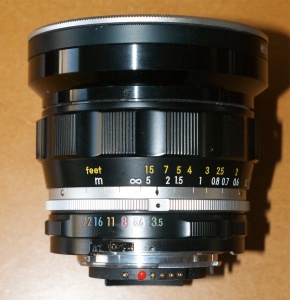

Nikkor 20mm f/3.5 UD and Ai-S wide-angle lenses.
Click to download the profile for either 20mm f/3.5 lens.
This file includes five profiles, at f/3.5, f/4, f/5.6, f/8 and at f/11. LR and PS will use the closest match. The 20mm f/3.5 – both UD and Ai-S – show moderate vignetting through f/5.6 and ‘wave like/mustache’ distortion of straight lines at all apertures. Both are corrected. The performance of the 20mm f/3.5 Ai-S needs no excuses, despite its tiny size. The UD handles better on the large ‘pro’ bodies and has similar optical performance.
I originally owned the Ai-S version, but sold it once I found the earlier UD in mint condition.
If you use a filter, make sure it’s a slim one.
Nikkor MF 20mm f/2.8 AiS Nikkor:
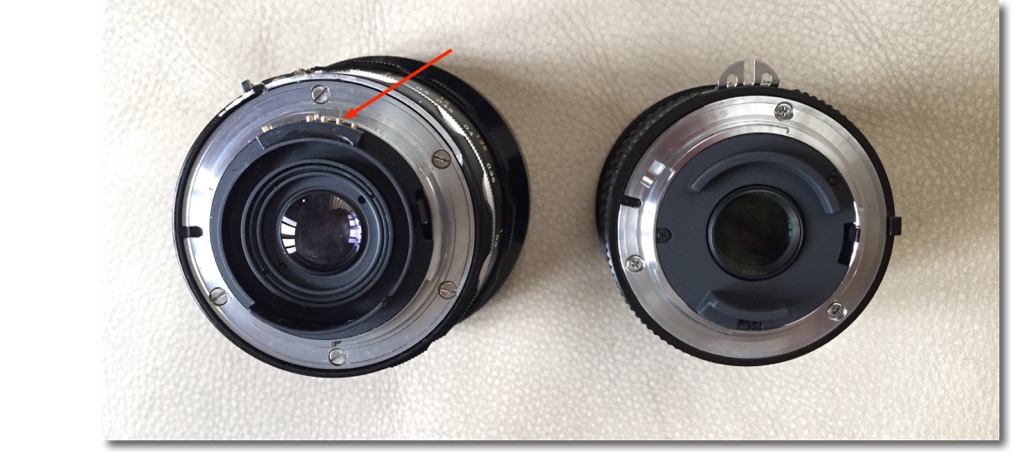
Nikkor 20mm f/2.8 Ai-S compared with the much older 20mm f/3.5 UD. Arrow denotes CPU installed on the UD.
Click to download the profile for the 20mm f/2.8 lens.
This file includes four profiles, at f/2.8, f/4, f/5.6 and at f/8. LR and PS will use the closest match. The 20mm f/2.8 – both UD and Ai-S – show pronounced vignetting at f/2.8 and f/4 and ‘wave like/mustache’ distortion of straight lines at all apertures. Both are corrected. Red fringing chromatic aberration is easily removed in Lightroom.
If you use a filter, make sure it’s a slim one.
Nikkor-N or N.C 24mm f/2.8 Ai’d:
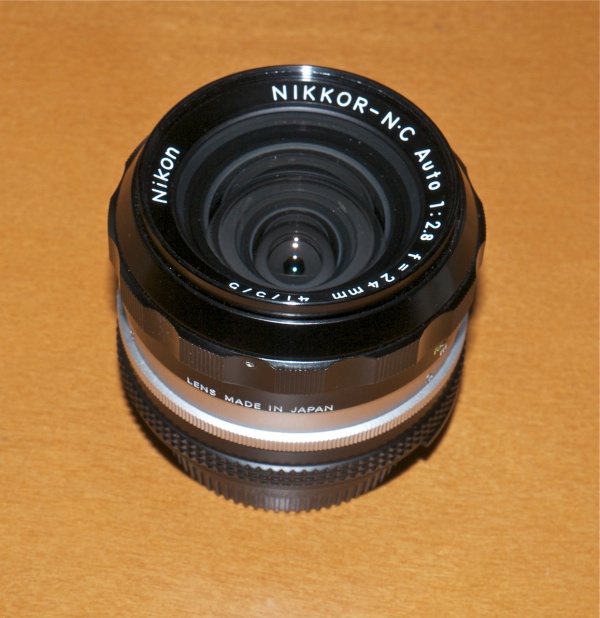
24mm Nikkor-N.C.
Click to download the profiles for the 24mm f/2.8.
This file includes two profiles, at f/2.8 and at f/5.6. LR and PS will use the closest match. The 24mm f/2.8 shows moderate vignetting at f/2.8 with minimal distortion at all apertures. By f/5.6 vignetting is negligible. An extraordinary piece of optical design.
This profile is for the pre-Ai version, which had 9 elements in 7 groups through serial number 519994. Starting with serial number 525001 in January 1977, the Ai version, the design was changed to 9 elements in 9 groups. I have not tested this profile with the later Ai lens.
If you use a filter, make sure it’s a slim one.
Nikkor-N or N.C 28mm f/2 Ai’d:
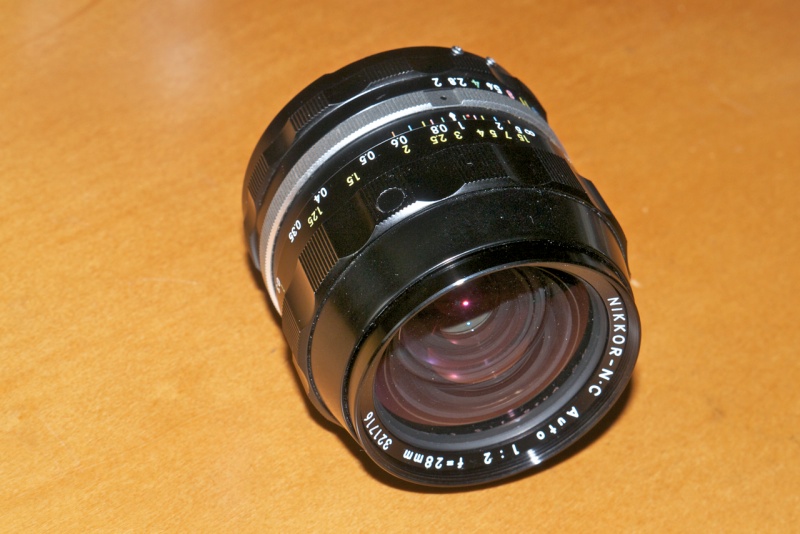
The aperture claw has been removed here, as it serves no purpose on modern digital bodies.
Click to download the profiles for the 28mm f/2.
This file includes four profiles, at f/2, f/2.8, f/4 and at f/5.6. LR and PS will use the closest match. The 28mm f/2 shows slight vignetting at f/2, disappearing by f/5.6 with very minor barrel distortion being corrected. Such chromatic aberration as there is, is so minor that only true pixel peepers will spot it, but LR easily removes what little there is.
This profile is for the pre-Ai and Ai versions, which had 9 elements in 8 groups. The profile for the later Ai lens appears below.
If you use a filter, make sure it’s a slim one.
Nikkor 28mm f/2 Ai:
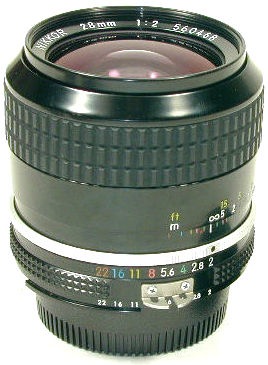
Click to download the profiles for the 28mm f/2 Ai
This Nikkor followed the pre-Ai one, above. If anything it’s even more solid in the hand and produces quite outstanding evenness of coverage, with vignetting almost completely gone by f/2.8. Resolution is on a par with the older optic. It is also 9 elements in 8 groups. This profile has been made at f/2, f/2.8, f/4 and f/5.6. Slight barrel distortion at all apertures is corrected. This lens belongs to a friend of the blog.
Nikkor-H 28mm f/3.5 Ai’d:
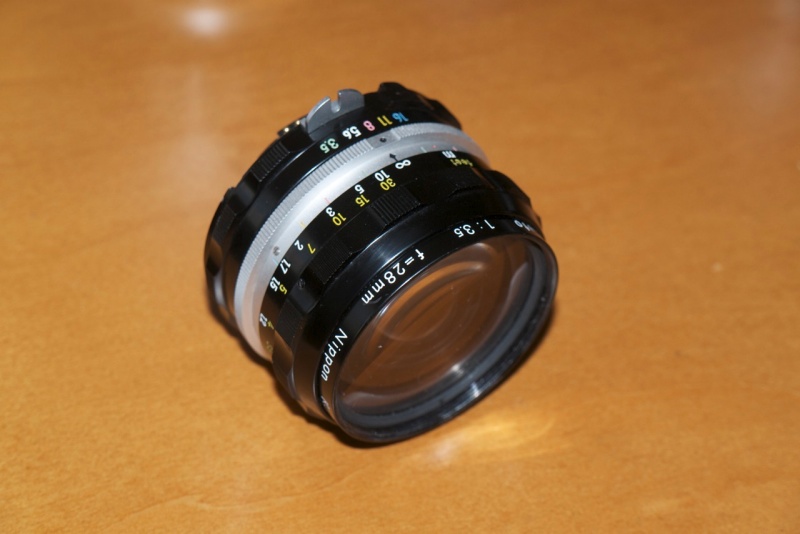
28mm Nikkor-H f/3.5.
Click to download the profiles for the 28mm f/3.5.
This file includes three profiles, at f/3.5, f/5.6 and at f/8. LR and PS will use the closest match. The 28mm f/3.5 shows vignetting at f/3.5, disappearing by f/5.6 with very minor barrel distortion being corrected.
This profile is for the pre-Ai and Ai versions, which had 9 elements in 8 groups. I have not tested this profile with the later Ai-S lens, though it appears to have a similar optical design.
Originally mine, I gave this lens to a friend.
If you use a filter, make sure it’s a slim one.
Sigma 35mm f/1.4 DG HSM A1 AF:
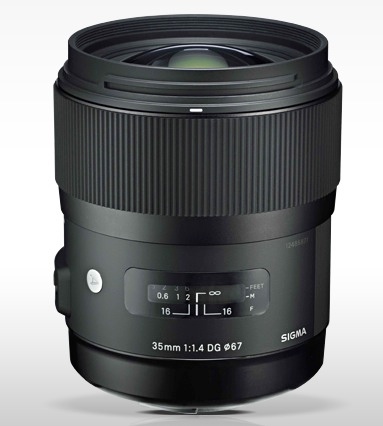
35mm Sigma f/1.4 DG HSM A1 for Nikon.
Click to download the profiles for the 35mm f/1.4 Sigma lens.
This file includes four profiles, at f/1.4, f/2, f/2.8 and f/4. LR and PS will use the closest match. The 35mm f/1.4 Sigma AF lens shows strong vignetting at f/1.4 and f/2 with a small amount of barrel distortion at all apertures. Full resolution is reached at f/2.5.
Update March 2013: Beta version 4.4 of Lightroom now includes Adobe’s version of this profile. It functions identically.
Nikkor 35mm f/1.8G AF-S DX:
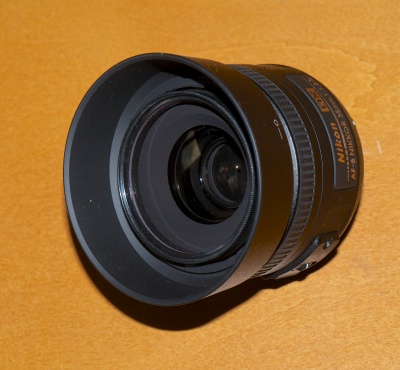
35mm Nikkor f/1.8G AF-S DX, with supplied hood.
Click to download the profiles for the 35mm f/1.8G.
Adobe’s profile included with LR and PS was created on an APS-C sensor. I have created this better alternative using an FF body making the lens more than useable on FF cameras. The profile will eliminate vignetting down to f/8 (at infinity) or f/11 (at 5 feet) making the lens a handy compact AF optic for use on FF bodies. Central definition is outstanding at all apertures down to f/16 on any sensor, and the edges hold perfectly well on APS-C and at f4 through f/11 on FF. The profile includes constituent profiles at every aperture from f/1.8 through f/22. This profile also eliminates significant barrel distortion and corrects for minor chromatic aberration.
Nikkor-O 35mm f/2 Ai’d:
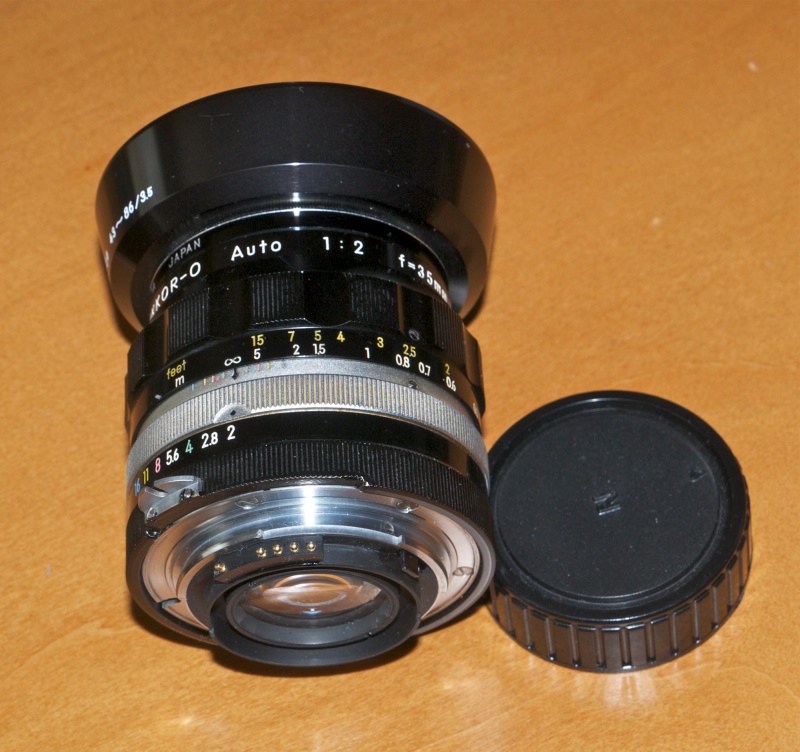
35mm Nikkor-O f/2, with period hood.
Click to download the profiles for the 35mm f/2.
This file includes three profiles, at f/2, f/2.8 and f/4. LR and PS will use the closest match. The 35mm f/2 shows moderate vignetting at f/2 and f/2.8 with a small amount of barrel distortion at all apertures. Full resolution is reached at f/4.
Nikkor AF 35-70mm f/2.8 (D or non-D):
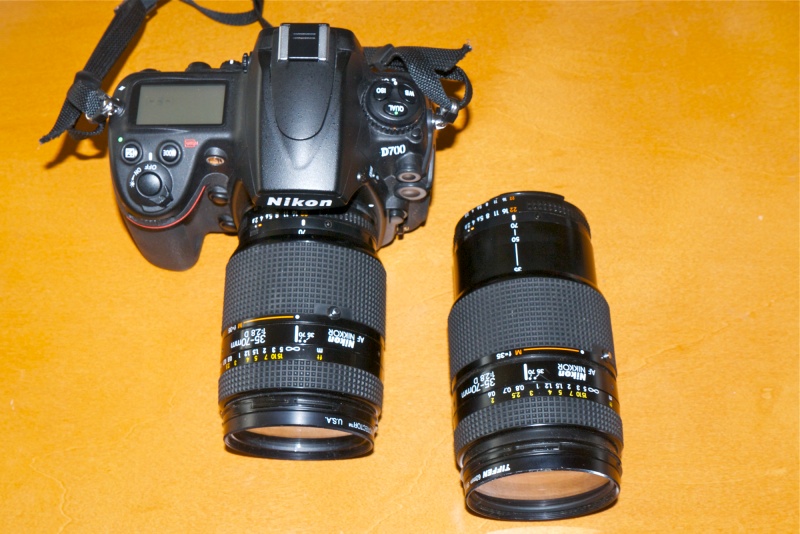
On the camera at 70mm and off at 35mm in Macro mode.
Click to download the profiles for the 35-70mm f/2.8 AF D zoom.
This file includes six profiles, at f/2.8 and f/5.6 at each of 35mm, 52mm and 70mm. This lens trends, like many zooms, from barrel distortion at the wide end to pincushion distortion at the long end. Vignetting at f/2.8 is largely gone by f/5.6. LR or PS will choose the closest aperture and focal length match.
This lens was succeeded by the 28-70mm and 24-70mm AF-S optics but is better made than either of those plastic efforts, being set in a solid metal barrel. Definition is fully up to the standard of the very latest Nikon optics – identical at 35mm to my 16-35mm f/4 AF-S VR.
Nikkor Ai 43-86mm f/3.5 Version II:
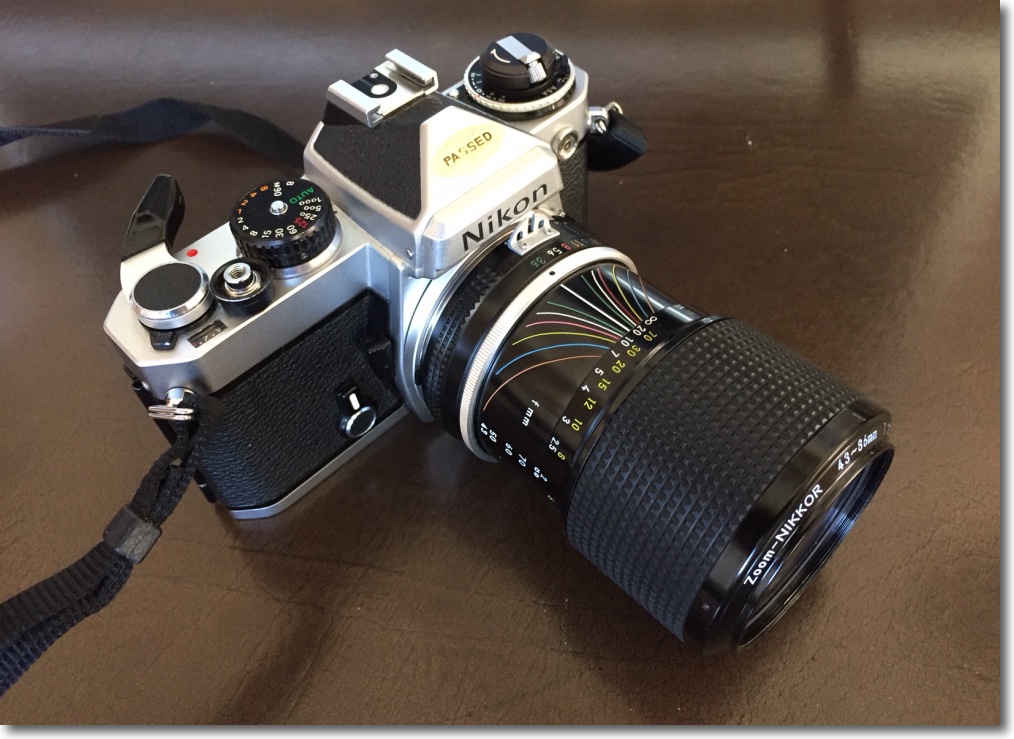
My ‘as new’ condition 43-86mm Zoom Nikkor on the Nikon FE film body.
Click to download the profiles for the 43-86mm f/3.5 Version IIzoom.
This file includes three profiles, at f/3.5, f/8 and f/16 at each of 43mm. This lens, like many zooms, suffers from barrel distortion at the wide end. Vignetting at f/3.5 is largely gone by f/5.6. LR or PS will choose the closest aperture and focal length match.
This lens was the first successful zoom for 35mm cameras and in Version I had very poor definition. Version II, distinguished by the lens identification on the barrel rather than on the front element retaining ring, fixed all that ailed Version I.
Nikkor-S 50mm f/1.4 Ai’d:
Note: This profile has been completely recreated on January 19, 2013, and is higher quality than the old one as well as adding f/5.6. The old profile only went through f/4. If you are using the older one, please update.
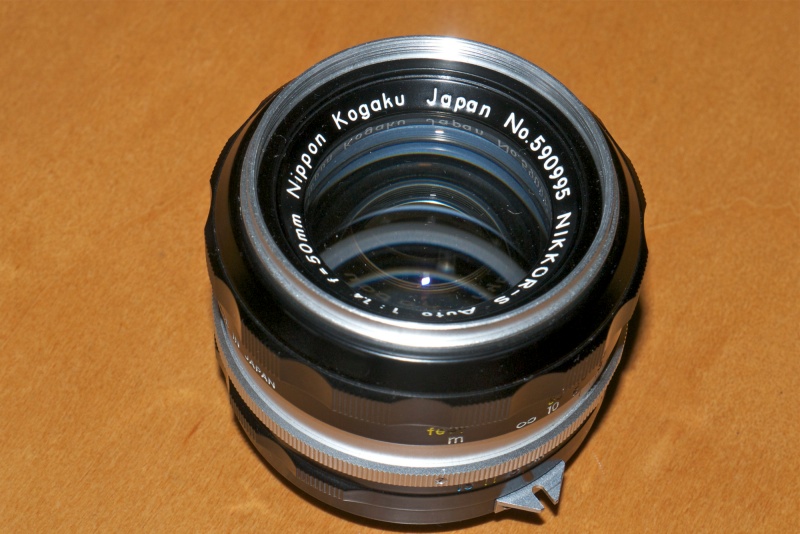
Click to download the profiles for the 50mm f/1.4.
This file includes five profiles, at f/1.4, f/2, f/2.8, f/4 and f/5.6. LR and PS will use the closest match. The 50mm f/1.4 shows moderate vignetting through f/4.0, with no linear distortion. Full resolution is reached at f/2.8.
Nikkor-H or HC 50mm f/2 Ai’d:
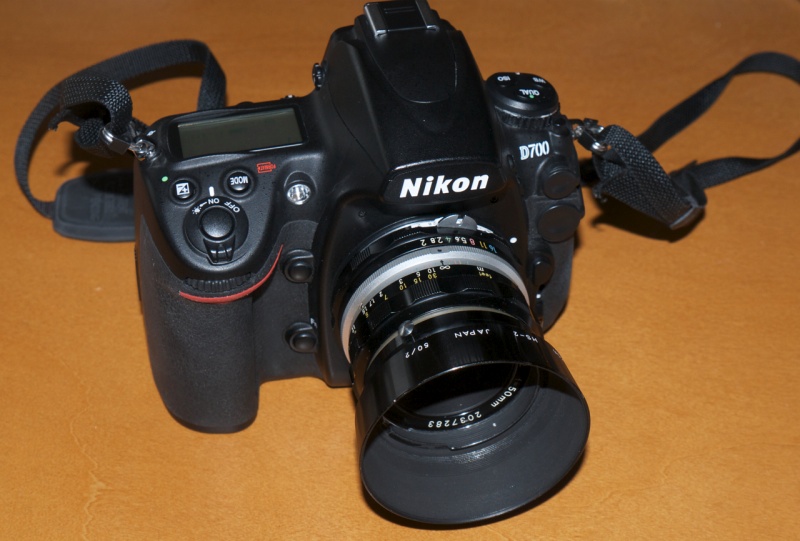
1972 50mm lens on a 2012 body.
Click to download the profiles for the 50mm f/2.
This lens in both single- (H) and multi-coated (HC) versions is one of the finest standard lenses ever made. Set in a fabulous all metal mount with a scalloped focusing ring, it’s well nigh perfect at all apertures with the merest shade of vignetting at f/2 and full sharpness being reached by f/3.5. A contemporary of the Leica Summicron, it has not been improved on since. The profile includes two files, at f/2 and at f/4. Slight barrel distortion is also corrected.
Originally mine, I gave this lens to a friend.
Nikkor 55mm f/3.5 Micro Nikkor macro lens.
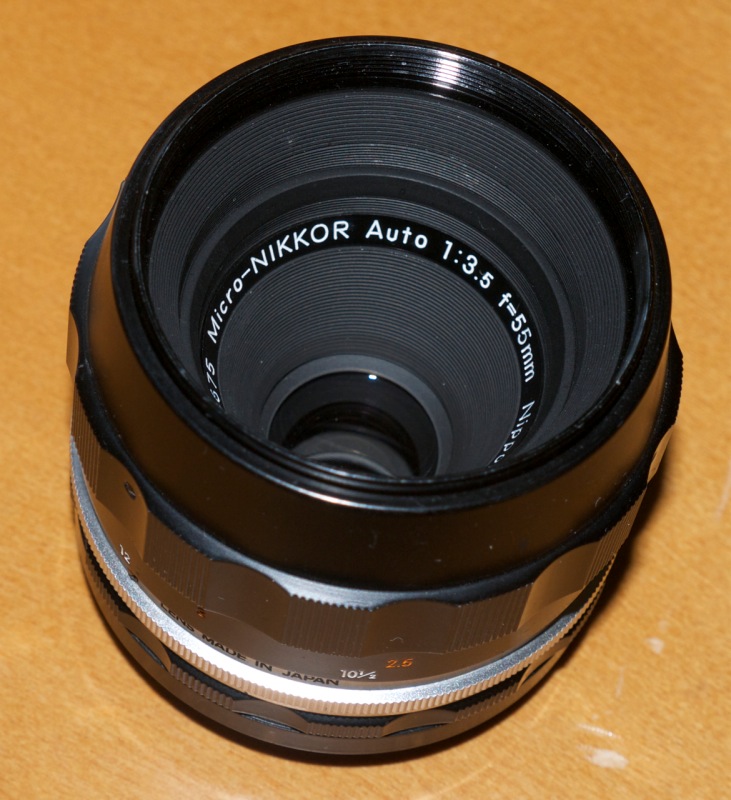
Click to download the profiles for the 55mm f/3.5 Micro Nikkor lens.
This file includes four profiles, at f/3.5, f/4, f/5.6 and f/8. LR and PS will use the closest match. The 55mm f/3.5 Micro Nikkor show near-negligible vignetting through f/4 and minor barrel distortion at all apertures. Both are corrected.
Nikon Series E 75-150mm f/3.5 Ai-S zoom:
Lens profiles for Manual Focus Nikkors have two limitations. You can only make an Auto-recognized profile at one focal length as there is no mechanism in the lens to tell the EXIF data which focal length was used. You can make multiple separate profiles, but you cannot bundle these into one file with the closest focal length automatically determined by LR or PS on import, unlike with the 35-70 AF D, above, for example. Secondly, the zoom lens, if it is to be chipped, must have a fixed aperture, or exposure metering will go haywire.
However, it’s still very much worth chipping this lens as the many benefits of a CPU are realized, save for the automatic recognition of focal length. Further, this optic is a simply stellar performer, light and small, so there’s every reason to modernize it.
Like most zooms, this lens suffers from barrel distortion at the wide end, and pincushion distortion at the long end, being pretty much linear in the middle. Vignetting is not significant. Accordingly I have made this profile at 112mm, the center of the zoom range, and it will be automatically recognized with a CPU installed when the CPU is programmed for a 75mm f/3.5mm lens. The lens will be recorded in the EXIF data as a 75mm f/3.5 – easy to recall as there are no other 75mm Nikkors. The CPU cannot be programmed for a zoom range.
Thus, after import, the user must adjust distortion manually, if required. In LR this is done in the Develop module, using Lens Corrections->Manual->Transform->Distortion. In my case, I find that images taken at 75mm require a +11 setting while those at 150mm dictate -7 on the slider, with appropriate settings in between. No need to try and remember the focal length used – just adjust the slider until parallel lines are straight, not curved. Conversely, you can back-estimate the focal length used by the setting of the slider! Other than that, everything works in a similar manner to all the other fixed focal length profiles here.

Click to download the profiles for the 75-150mm f/3.5 Nikon Series E zoom.
Nikkor-H 85mm f/1.8 Ai’d:
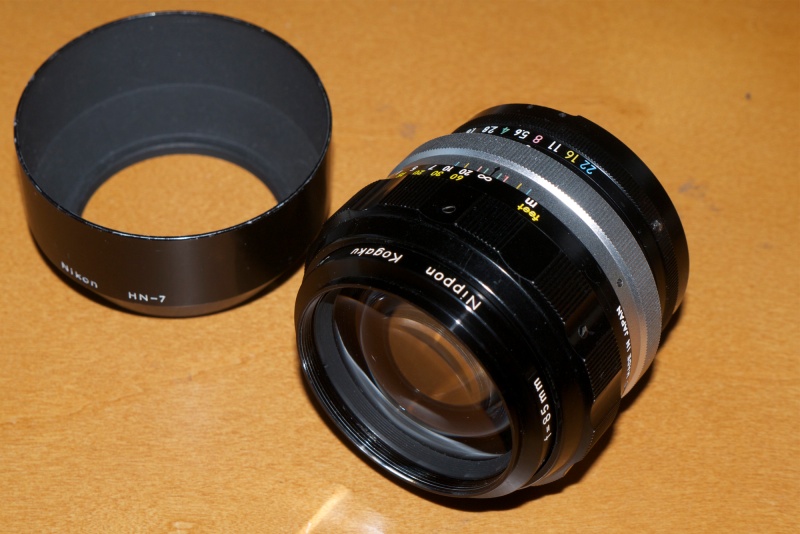
Click to download the profiles for the 85mm f/1.8
This famous lens, used by David Hemmings in Michelangelo Antonioni’s epic ‘Blow-Up’, is an outstanding portrait lens on both FX and DX sensors. Like the 50mm Nikkor-H it is set in a fabulous all metal mount with a scalloped focusing ring. It’s well nigh perfect at all apertures with the merest touch of vignetting through f/4. The profile has been made at f/1.8, f/2.8, f/4 and f/5.6, to correct vignetting. This lens shows absolutely no linear distortion.
Nikkor-P 105mm f/2.5 Ai’d:
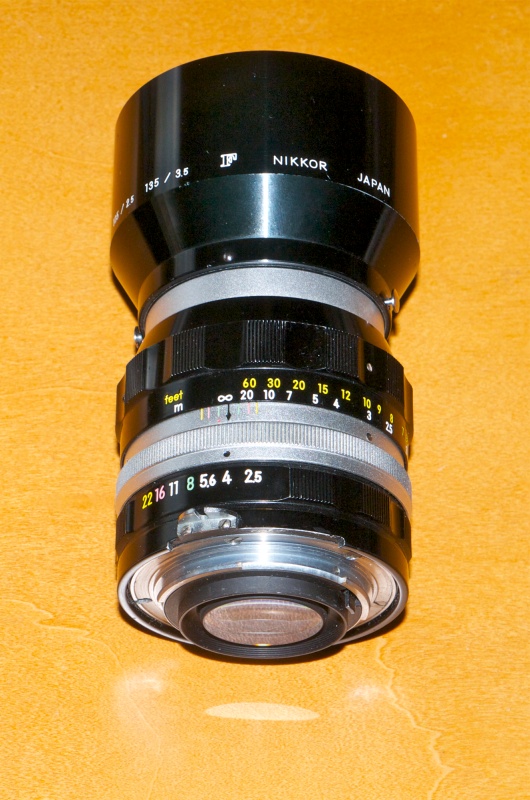
Click to download the profiles for the 105mm f/2.5
This lens is one of the finest portrait lenses ever made. Like the 50mm Nikkor-H it is set in a fabulous all metal mount with a scalloped focusing ring. It’s well nigh perfect at all apertures with a touch of vignetting at f/2.5, fully open. The profile has been made at f/2.5 and f/5.6, to correct vignetting at full aperture. This lens shows absolutely no linear distortion.
This lens came in two versions – the earlier ‘Sonnar’ type with 5 elements in 3 groups, and the later ‘Gauss’ type with 5 elements in 4 groups. This profile is for the earlier ‘Sonnar’ type.
While there are two profiles here for 105mm lenses, Lightroom uses the combination of the focal length and maximum aperture to select the correct one automatically on import, so the 105/2.5 profile will not be confused with the 105/4 Micro one.
Micro-Nikkor 105mm f/4 Ai and Ai-S:
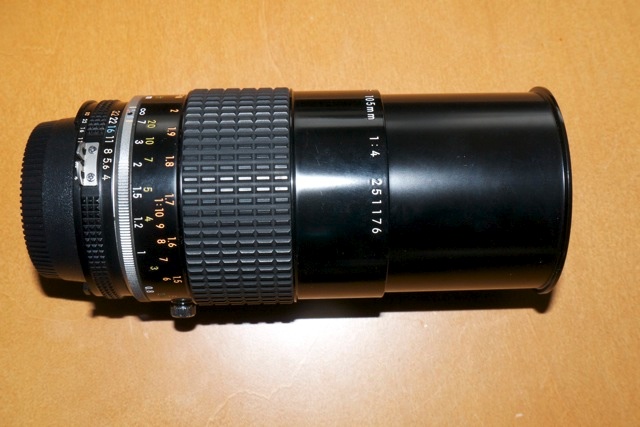
Click to download the profiles for the 105mm f/4 Micro Ai and Ai-S
By common acclaim this is perhaps the finest macro lens made in this focal length. Later versions added speed, automation and plastic. None are needed in the intended applications for this optic. The lens is incredibly sharp at all apertures down to f/11 (thereafter diffraction sets in) with the merest shade of vignetting at f/4, fully open. The profile was made at f/4 and f/8. Minor vignetting disappears by f/5.6. This lens reminds me of my Sabatier non-stainless chef’s knife. Scary sharp and easily out-resolving the FF sensor in the D700 body.
While there are two profiles here for 105mm lenses, Lightroom uses the combination of the focal length and maximum aperture to select the correct one automatically on import, so the 105/2.5 profile will not be confused with the 105/4 Micro one.
Nikkor-Q 135mm f/3.5 Ai’d:
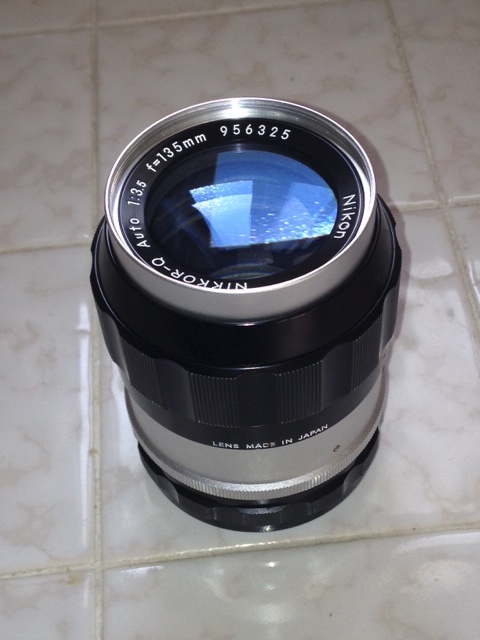
Click to download the profiles for the 135mm f/3.5
This lens is of simple construction and excellent mechanical and optical quality. The profile has been made at f/3.5 and f/5.6, but in reality the aberrations are so minor that its use is hardly essential.
Nikkor-Q 200mm f/4 Ai’d:
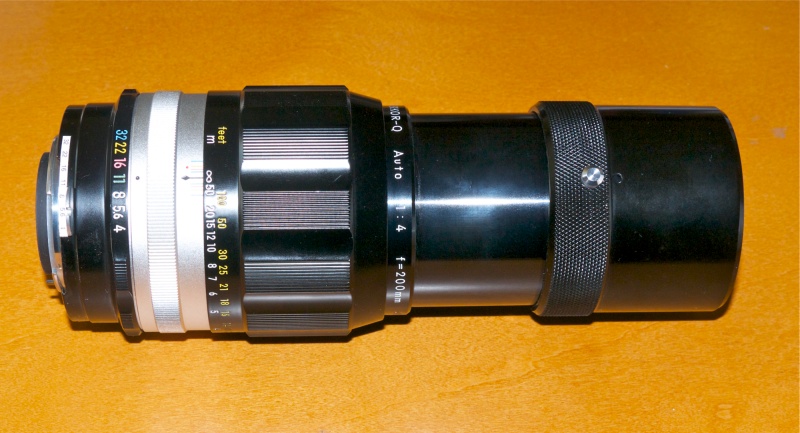
Click to download the profiles for the Nikkor-Q 200 f/4 lens.
Every self-respecting photographer should have this lens in his arsenal. Fabulously sharp at any aperture and built like the work of the mechanical engineer’s art which it is, it is criminally inexpensive on the used market, and widely available. I made this profile at f/4 (where light vignetting intrudes) and f/8 (where vignetting is almost totally absent) with very minor pincushion distortion being corrected at all apertures.
Nikkor 300mm f/4.5 ED-IF Ai-S:
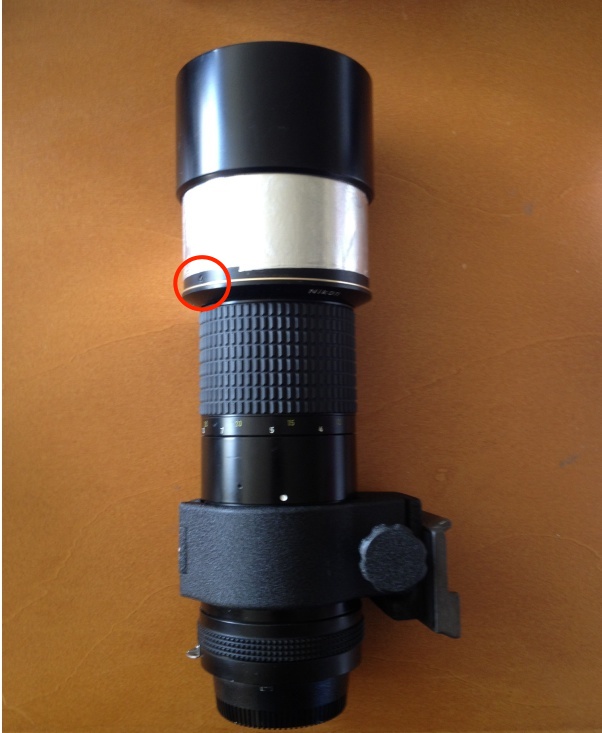
300mm MF Nikkor. Flue Tape prevents hood wobble.
Circle denotes one of the three trombone retaining screws.
Click to download the profiles for the Nikkor 300 f/4.5 ED-IF Ai-S lens.
This profile was made at f/4.5 and f/8, and corrects modest vignetting at f/4.5 as well as some chromatic aberration.
Nikkor 500 f/8 Ai Reflex N mirror lens:
This lens, like many mirror optics, suffers from ‘hot spotting’ – the center of the image has a brighter circular zone. There is also minor pincushion distortion but no detectable chromatic aberration. This profile is for the last version of the lens, the one with the ultra-close focus ability denoted by the orange ring on the focus collar. Use this profile and you will make an already great lens even better. Learn how to make this much maligned lens sing by clicking here.
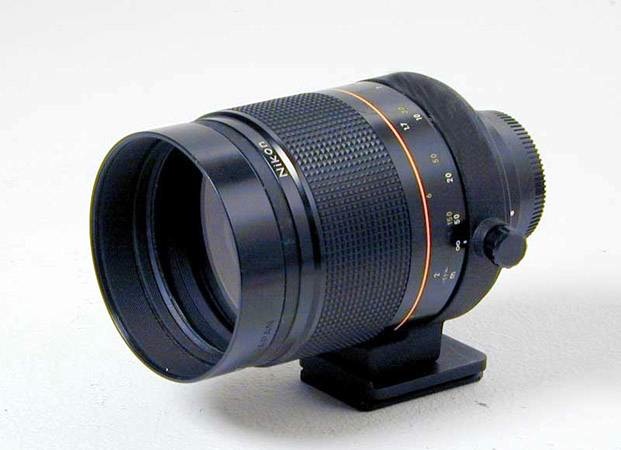
Click to download the profile for the 500mm Nikkor f/8 AI N Reflex lens.
Olympus M.9-18mm f/4-5.6 MFT lens:
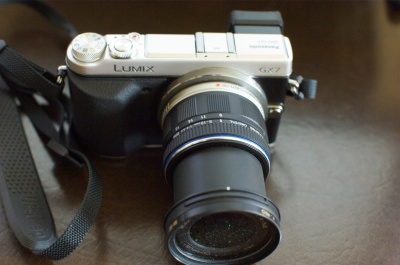
Compact and sharp at all apertures, this MFT lens fits all Olympus and Panasonic MFT bodies. The profile was created using a Panasonic G3 but should work equally well on other models. The profile file contains no fewer than 8 profiles, created at 9mm (f/4, f/5.6), 11mm (f/4.3, f/5.6), 14mm (f/4.9, f/7.1) and 18mm (f/5.6, f/11) at the apertures shown. Lightroom will automatically chose the profile nearest in focal length and aperture to your photograph’s EXIF data. This profile is only required when the lens is used on a Panasonic body, Olympus MFT bodies providing in camera correction of lens aberrations.
Click to download Olympus 9-18mm MFT lens profile for the
Panasonic G-series body. For RAW originals only.
Olympus 17mm f/1.8 MFT lens on a Panasonic GX7 body.
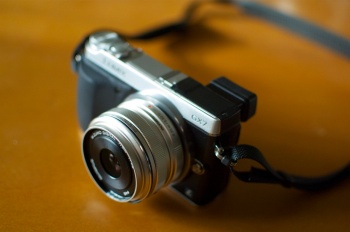
A very fast focusing and fast aperture street snapper, this compact MFT lens fits all Olympus and Panasonic MFT bodies. The profile was created using a Panasonic GX7 but should work equally well on other models. The profile file contains 5 profiles, created at f/1.8, f/2, f/2.8, f/4 and f/5.6 by which aperture vignetting pretty much disappears. Minor barrel distortion at all apertures is also corrected. Lightroom will automatically chose the profile nearest in focal length and aperture to your photograph’s EXIF data. This profile is only required when the lens is used on a Panasonic body, Olympus MFT bodies providing in camera correction of lens aberrations.
Click to download Olympus M.17mm f/1.8 MFT lens profile for the
Panasonic G-series body. For RAW originals only.
Olympus 45mm f/1.8 MFT lens on a Panasonic GX7 body.
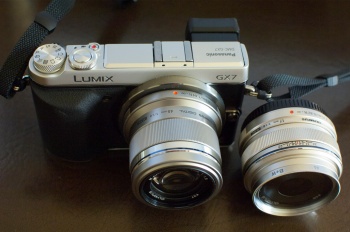
The 17mm/1.8 is on the right, for comparison.
A fast focusing portrait lens of very compact dimensions, this MFT lens fits all Olympus and Panasonic MFT bodies. The profile was created using a Panasonic GX7 but should work equally well on other models. The profile file contains 5 profiles, created at f/1.8, f/2, f/2.8, f/4 and f/5.6. Mild vignetting is almost invisible by f/2.8 and smaller, and noticeable pincushion distortion, visible at all apertures, is also corrected. Lightroom will automatically chose the profile nearest in focal length and aperture to your photograph’s EXIF data. This profile is only required when the lens is used on a Panasonic body, Olympus MFT bodies providing in camera correction of lens aberrations.
Click to download Olympus M.45mm f/1.8 MFT lens profile for the
Panasonic G-series body. For RAW originals only.
iPhone 1.54mm f/2.4 lens in the iPhone 11 and iPhone 11 Pro.
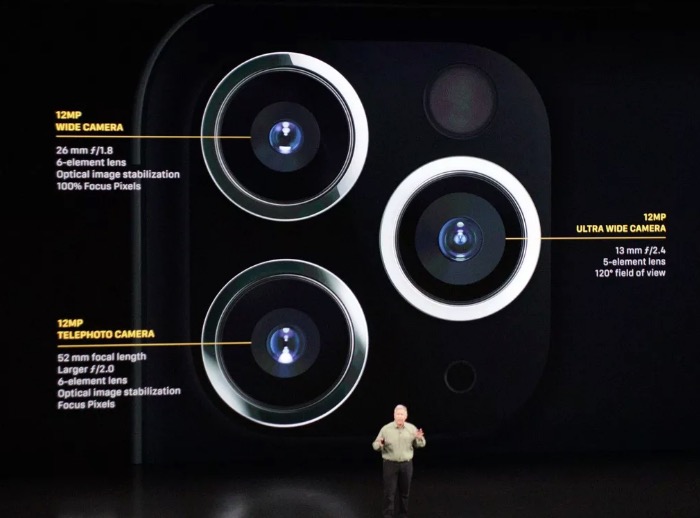
Click to download Apple 1.54mm f/2.4 UWA lens profile for the
iPhone 11/11 Pro. For JPG originals only.
This wild and very wide (13mm FFE) lens in the iPhone 11 may be fixed focus, but no excuses need be made for its quality. At 1.54mm focal length, focusing is unnecessary. However, Apple by choice elects not to correct its distortions, something it does do for the standard and tele lenses in the iPhone 11.
You must invoke this profile manually in Lightroom as there is no way to tell the program to do so automatically.
Applying lens profiles automatically in Lightroom 3/4/5/6/CC:
Ordinarily, Lightroom’s Develop module has to be told to apply the lens profile and a box checked to correct chromatic aberration. If you install a CPU in your lens and create a User Preset (Develop->New Preset) and apply that when importing your pictures, making sure to check the boxes circled in red below, then both the lens profile and the correction of chromatic aberration will be applied automatically:
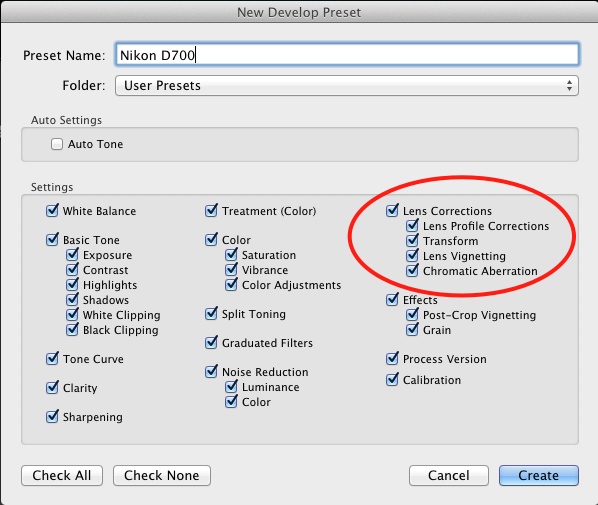
Applying lens profiles in Lightroom 3/4/5/6/CC automatically.
Note that for old MF Nikkors, either a CPU must be installed or you need to dial in the lens focal length and maximum aperture when taking the photograph, for automatic profile recognition to work. A CPU is the way to go as there is nothing to forget, especially after changing lenses.
Ai conversions:
To learn how to do your own conversions of pre-Ai lenses to Ai, allowing use on current bodies, click here.
Fantastic work !!
a 20mm/f3.5Ai and 35-70mm/f2.8 are the two lenses I use most !!!
You could also mention, that to use those profiles on .tiff files, one can easily convert them directly in Lightroom to DNG (using Export function).
thanks
Andy
Terrific.
I’m in love with my 50mm 1.4
Was my first nikkor lens, and no matter what camera come to my hands, I just take off his lens and set my 1.4
Many thanks for the profiles.
Question: the profile I downloaded is “NIKON D700 (20.0 mm f3.5) – RAW.lcp” – does this mean it is appropriate only for D700? I have a different FX body.
Thank you for compiling this comprehensive set of great older lenses, Thomas.
I have added an explanatory paragraph, above. The profile is recognized by lens focal length and maximum aperture, not by the camera body name in the profile. This means these profiles will work on all FX (full frame) and DX (APS-C cropped frame) Nikon digital bodies. – Ed.
Thomas, thank you! Thank you! Thank you!
I was searching the internet trying to find out why my newly created lcp files were not being used in LR 5. I first created it with JPG files, then tried TIF files – no luck. Then I stumbled across your other posting stating that I had to use DNG files. Bingo! That worked. I have created a bare bones lcp file for a 28-80 Nikon lightweight zoom (only 7 ounces) that I carry on my D600 when backpacking. Thanks again.